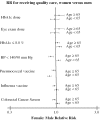Quality of ambulatory care for women and men in the Veterans Affairs Health Care System
- PMID: 16050889
- PMCID: PMC1490181
- DOI: 10.1111/j.1525-1497.2005.0160.x
Quality of ambulatory care for women and men in the Veterans Affairs Health Care System
Abstract
Background: Gender differences in inpatient quality of care are well known. However, whether men and women receive equivalent ambulatory care is less well understood.
Objective: To study gender differences in quality of care for patients receiving primary care in the Veterans Affairs (VA) Health Care System.
Design: Cross-sectional samples of VA enrollees during fiscal years 1999 to 2000.
Participants: Samples of 6,442 to 86,405 men and women treated at VA facilities for whom at least 1 of 9 quality measures was available.
Measurements: Appropriate general preventive services (pneumococcal vaccination, influenza vaccination, colorectal cancer screening), and specific services for diabetes (annual hemoglobin A1c [HbA1c] testing, good glycemic control, annual diabetic eye exam), hypertension (good blood pressure control), or prior myocardial infarction (use of beta-blockers or aspirin).
Results: In adjusted analyses, there were no substantial gender differences in rates of appropriate care. For women compared with men, the adjusted relative risk for appropriate care ranged from 0.96 for blood pressure control (95% confidence interval: 0.93 to 0.99; P=.02) to 1.05 for HbA1c< or =8.0% (95% confidence interval: 1.03 to 1.07; P<.01). Analyses stratified by age demonstrated equivalent care between men and women in 9 of the 14 subgroups evaluated.
Conclusions: In this large national health care system that predominantly serves men, the quality of ambulatory care is equivalent for women and men on numerous measures.
Figures
References
-
- Ayanian JZ, Weissman JS, Chasan-Taber S, Epstein AM. Quality of care by race and gender for congestive heart failure and pneumonia. Med Care. 1999;37:1260–9. - PubMed
-
- Udvarhelyi IS, Gatsonis C, Epstein AM, Pashos CL, Newhouse JP, McNeil BJ. Acute myocardial infarction in the medicare population. Process of care and clinical outcomes. JAMA. 1992;268:2530–6. - PubMed
-
- Ayanian JZ, Epstein AM. Differences in the use of procedures between women and men hospitalized for coronary heart disease. N Engl J Med. 1991;325:221–5. - PubMed
-
- Canto JG, Allison JJ, Kiefe CI, et al. Relation of race and sex to the use of reperfusion therapy in medicare beneficiaries with acute myocardial infarction. N Engl J Med. 2000;342:1094–100. - PubMed
Publication types
MeSH terms
Grants and funding
LinkOut - more resources
Full Text Sources

